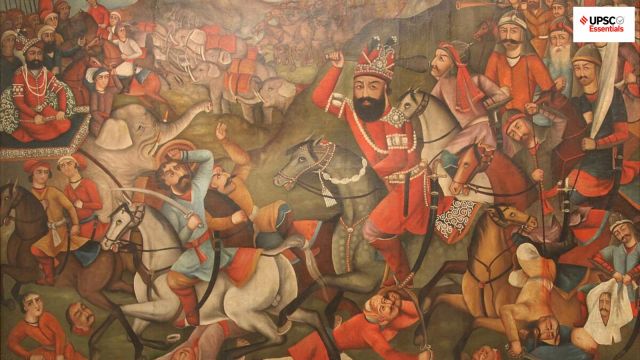
QUESTION 1
U V Swaminatha Iyer and C W Damodaran Pillai are known in history for:
(a) the ‘rediscovery’ of Sangam literature
(b) the unification of South Indian princely states.
(c) the excavation at Keeladi
(d) the discovery of the graffiti marks in Thulukarpatti, a Chola site
Explanation
Two people credited with ‘rediscovering’ Sangam texts were U V Swaminatha Iyer and C W Damodaran Pillai. Iyer, popularly known as “Tamil Tatha (Tamil grandfather)”, was a professor of Tamil at the Government Arts College at Kumbakonam. During his tenure there, he came to be acquainted with Salem Ramaswami Mudaliar, a lawyer and independence activist, who introduced him to an ancient text called Chintamani. The text transformed his life, and from then on, Iyer devoted the rest of his life to unearthing and editing ancient Tamil literature. In his efforts, he was joined by Pillai, who practised law at Kumbakonam and was a zealous advocate for the richness and antiquity of the Tamil language.
The texts collected and documented by Iyer and Pillai were mostly written on palm leaves. Many of them were on the verge of being destroyed, and several carried incomplete verses.
Therefore, (a) is the correct answer.
QUESTION 2
The Battle of Karnal (1739) was fought between:
(a) Mughal Emperor Muhammad Shah and Persian ruler Nadir Shah
Story continues below this ad
(b) Mughal Emperor Muhammad Shah and Afghan ruler Ahmad Shah Durrani
(c) Mughal Emperor Farrukhsiyar and Persian ruler Nadir Shah
(d) Mughal Emperor Alamgir II and Afghan ruler Ahmad Shah Durrani
Explanation:
The Battle of Karnal on February 24, 1739 all but sealed the eventual fate of the once mighty Mughal Empire.
The army of Nadir Shah, founder of the Afsharid dynasty of Iran, defeated the forces of Mughal emperor Muhammad Shah ‘Rangila’ in under three hours. The Shah of Iran subsequently captured and sacked Delhi, the Mughal capital, and emptied the royal treasury, taking home the fabled Peacock Throne and the Koh-i-noor diamond embedded on it.
Therefore, (a) is the correct answer.
Story continues below this ad
QUESTION 3
With reference to History of Modern India, consider the following statements:
1. The slogan “Pagri Sambhal Jatta” was coined by Ajit Singh who started a movement by the same name in 1907.
2. The “Pagri Sambhal Jatta” movement was started in protest against three agricultural laws imposed by the British.
Which of the above given statements is/are true?
(a) 1 only
(b) 2 only
(c) Both 1 and 2
(d) Neither 1 nor 2
Explanation:
In 1907, Ajit Singh started the Pagri Sambhal Jatta movement in protest against three agricultural laws imposed by the British. ‘Pagri Sambhal Jatta’ literally translates to ‘take care of your turban, o farmer’, and invokes self respect and honour. Hence, statement 2 is correct.
Story continues below this ad
The three laws were: The Punjab Land Alienation Act, 1900; The Punjab Land Colonisation Act, 1906; and The Doab Bari Act, 1907.
Ajit Singh and Kishan Singh (Bhagat Singh’s father) formed the Bharat Mata Society, a revolutionary group for farmers. Lala Lajpat Rai and other leaders also supported the movement. The slogan “Pagri Sambhal Jatta” was coined by Banke Dayal, a nationalist poet, and became a symbol of resistance. Hence, statement 1 is incorrect.
Therefore, (b) is the correct answer.
QUESTION 4
He was arrested in London in March 1910, on charges of anti-state acts and abetment of Nashik magistrate A M T Jackson’s murder. While being brought to India for trial onboard the commercial ship SS Morea, he tried to escape from custody in Marseille. He references his attempted sea escape in his Marathi biographical work Mazi Janmathep, first published in 1927.
Identify the historical personality from the above passage:
(a) Dhondo Keshav Karve
(b) Vinayak Damodar Savarkar
(c) Nanaji Deshmukh
(d) Bal Gangadhar Tilak
Explanation:
While in Marseille, Prime Minister Narendra Modi wrote about the port city’s “special” connection to India’s struggle for Independence.
Story continues below this ad
Vinayak Damodar Savarkar was arrested in London in March 1910, on charges of anti-state acts and abetment of Nashik magistrate A M T Jackson’s murder. While being brought to India for trial onboard the commercial ship SS Morea, Savarkar tried to escape from custody in Marseille.
SS Morea had sailed from London on July 1, 1910. It docked at Marseille a week later.
Therefore, (b) is the correct answer.
QUESTION 5
Which are the historical/cultural sites often called as a part of ‘The Diamond Triangle’:
(a) Ratnagiri, Udaygiri, and Lalitgiri
(b) Bodh Gaya, Rajgir, Nalanda
(c) Ajanta Caves, Ellora Caves, Elphanta Caves
(d) Brihadeeswarar Temple, Meenakshi Temple, Chidambaram temple
Explanation:
Odisha has a rich Buddhist heritage. Ratnagiri, part of the ‘Diamond Triangle’ of Ratnagiri, Udaygiri, and Lalitgiri, had a flourishing monastery where monks of the Vajrayana sect of Buddhism lived during the reign of the Bhauma-Kara kings.
Story continues below this ad
The recent discovery of three colossal Buddha heads, a giant palm, an ancient wall, and some inscriptions have underlined the significance of Ratnagiri in Odisha’s Jajpur district as a prominent Buddhist historical site.
The Archaeological Survey of India (ASI) has now decided to take up fresh surveys at the Ratnagiri Buddhist heritage site more than 60 years after it was first excavated.
Therefore, (a) is the correct answer.
Subscribe to our UPSC newsletter and stay updated with the news cues from the past week.
Stay updated with the latest UPSC articles by joining our Telegram channel – IndianExpress UPSC Hub, and follow us on Instagram and X.


































